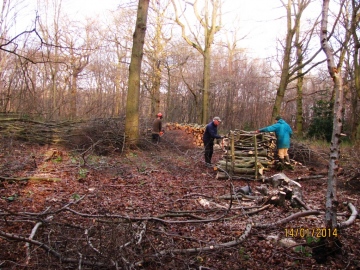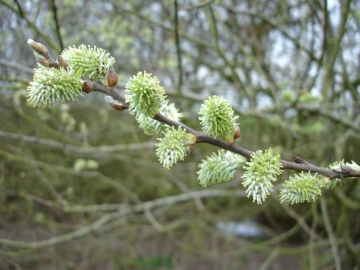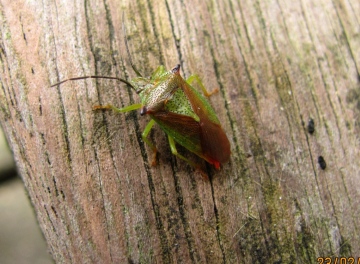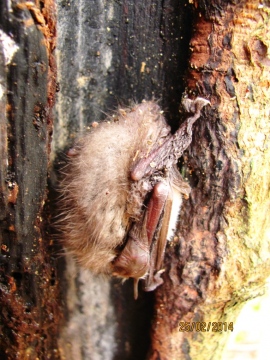Not everyone agrees though. Some see the felling of even a single oak tree as a sacrilegious act. No amount of discourse about grassland restoration, the loss of nearly all our species rich meadows in the past fifty years, or even a last desperate appeal that they should consult that great oracle of the modern age, Google, does any good. In the end we volunteers leave such pedants to the warden. He seldom has much luck either. The conversation usually ends with an adamant “I don’t care what anyone says, I will never change my mindâ€! On this and much else in their lives I would bet. For ever and ever. Until amen. I know quite a few people like that! Still, I too was unaware the important part played by coppicing in maintaining our woodlands and the wildlife therein until enlightened by Oliver Rackham, so I should not crow too loudly.
Thrift Wood is ancient woodland and may well have had a regular coppicing cycle in the past but unfortunately no one bothered to record it; either that or such records have been lost. Not so Stoneymore Wood, Mill Green. It - along with the Forest springs at Writtle Park and other major woodlands in the area - had probably been coppiced on a regular basis for several centuries before Sir William Petre acquired the estate in the mid-1500s as there are wood sale accounts in the court rolls dating back to at least 1396 (Rackham 2003). However, the practice was not spelled out in detail until a survey of 1781, when it was stated that :
“In the woods…….after the cutting of the Copse Wood, Lord Petre has the right to enclose them for the space of seven years, after which it is thrown open to the tenants of the manor for a further space of ten years, when it is again cut down as Lord Petre’s propertyâ€
The seventeen year coppice cycle implied by the 1781 survey was not strictly adhered to and in practice ranged between eight and nineteen years, with a tendency to lengthen in later decades. For instance, Rackham (2003) states that Great Edney Wood was coppiced in 1691, 1703 and 1711 while surviving wood-books from the late 18th to the late 19th century list Great Stoneymore as being coppiced in 1787, 1800, 1819, 1836, 1850, 1864, 1877 and 1888-89 and Little Stoneymore in 1788, 1800, 1817, 1835, 1848 and 1863. These, of course, were years of major coppicing, when the entire wood was harvested, but smaller transactions would undoubtedly have occurred in other years. An account book of 1800 kept by one William Robertson gives a detailed breakdown of the costs and profits involved. John Clarke & Co was paid £36. 8s 0d for felling 52 acres in Great & Little Stoneymore Woods, at 14s per acre. They also received £77 4s 0d for providing 386 rods of hedging and ditching for use in the same , at 4s per rod, and £8 13s 7d for sundry other items. Solomon Stubbing charged his Lordship £18 8s 6d for 20,000 quicksettes for the new fence around the coppice and William Mullnicks £5. 5s 0d for 500 bush faggotts. William Cocks & Co claimed £2.15s 10d for stopping gaps in the fence separating Deerslade from The Mores (part of Mill Green Common) and for digging post holes in the two Stoneymores while John Otley employed two men for twelve days ditching up gateways in the woods and for this service charged Lord Petre £1. 6s 0d. Finally, John Dawson was paid £1 9s 2d for gate irons and John Bannister 15s for two padlocks In return the Petre Estate received £794 from Messer’s Collins for the coppice wood from Great Stoneymore and £804 from Messer’s Tindel for that in Little Stoneymore. In addition, Henry Finch paid £51 18s 3d for eight loads and twelve yards of bark and Joseph Hills £5 16s 0d for one load and eight yards of oak timber. Thus the income amounted to £1655 14s 3d and the outgoings £125 4s 11d, a profit of £1539 19s 2d. It sounds a lot but, of course, it had been thirteen years since the previous coppice and £1540 divided by 13 = approximately £118 10s per annum. According to Measuring Worth.com, £1 today would have been worth £68.40 in 1800. At school I always viewed mathematics as one of the dark arts but Google makes it easy! According to them, £118.50 x £68. 40 comes out at around £8,105, a relatively modest annual return but a cheque for the equivalent of £105,000 (8,105 x 13) after 13 years would have kept his Lordship in ermine for many a day! (At Thrift the the coppiced firwood makes around £2000 for the Trust each winter and where Sweet Chestnut is involved also yields a good crop of fence posts for use on other reserves).
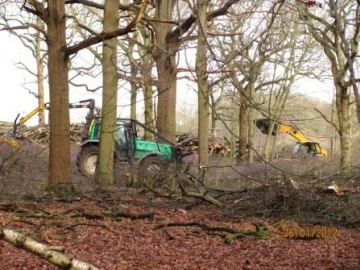 Coppicing modern day style - Deerslade Wood
Coppicing modern day style - Deerslade Wood
The seasonal flow continues, as yet unhindered by any sign of prolonged cold weather. Goat Willow catkins are now bursting with pollen in many a hedgerow and woodland margin and Common Whitlow Grass is in abundant bloom along the seawall at Blue House.
There was a fine male Brimstone on the wing on 22nd at The Backwarden, Danbury and my second Bumblebee species of the year, the Buff-tailed Bombus terrestris, was nectaring at Bergenia flowers in the garden yesterday. Most nights have been too chilly to set the moth trap but there have been a few Common Quakers on the wing and this Hawthorn Shieldbug turned up one evening recently.
Finally, disaster was narrowly avoided during a work party at Hitchcock’s Meadows EWT Reserve this week as we were about to topple a small dead oak tree in order to clear a fence line. Part of the trunk broke away to reveal this hibernating bat in a small hollow underneath. I’m not sure it is identifiable from the photograph but it was very small and I imagine it to be one of our two species of Pipistrelle. The snapped off section of trunk was carefully replaced and secured with binder twine– so hopefully no harm done - but we proceeded much more cautiously with our task after that!
























